Gazing at Gulls
Don’t be gull-ible in believing there are “seagulls.” Great black-backed gulls, herring gulls, ring-billed gulls, laughing gulls and Bonaparte’s gulls—yes!
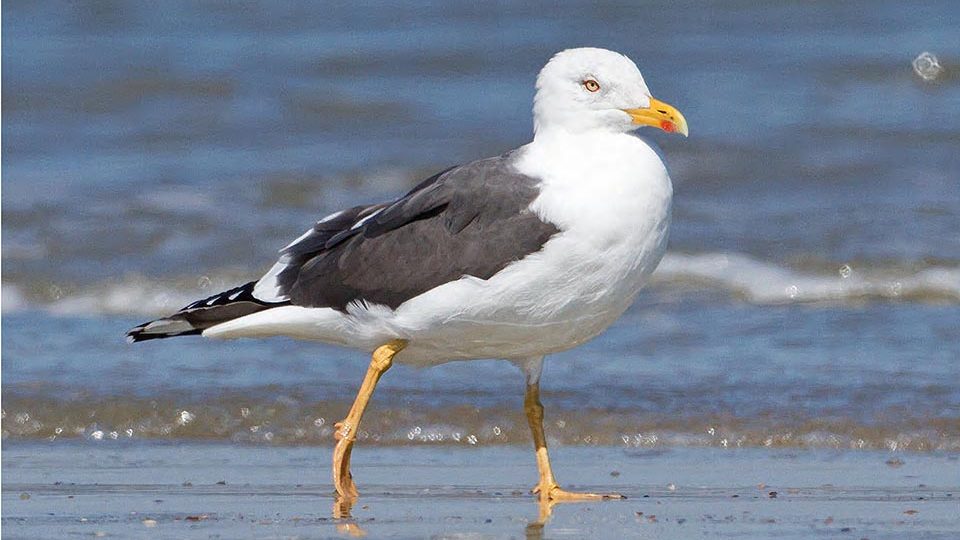
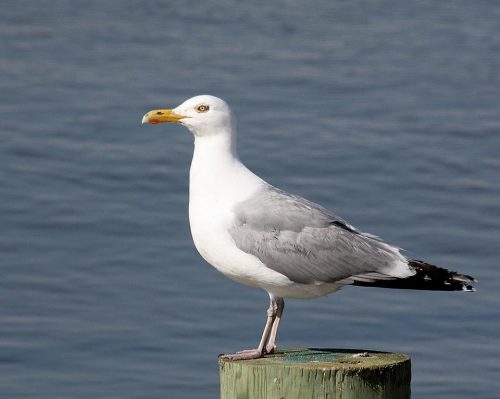
Well, I consider myself a person who enjoys looking at birds, rather than a birder. That’s probably because in our region we are blessed with a number of really “serious” birders—folks whose hobby consumes most of their time when in the great out-of-doors, or who make a living assembling environmental inventories for builders or other scientists. These are people who can identify most birds by their call and by only a glimpse of their flight pattern.
Clay Sutton, one of our region’s famed ornithologists, tells me, “You are too a birder.” It is true, I have travelled the world looking at birds and I suppose although I do not have a written life list my count exceeds most serious birder’s numbers. But in knowledge and passion for our local feathered denizens, and even for those in faraway places, my skills are far exceeded by many.
About 35 years ago, while in the field with a true professional, I identified a bird as some kind of seagull. He corrected me, saying, “There are no seagulls.”
I said, “I didn’t say the kind of seagull. Just a seagull.”
He persisted, “No seagulls.”
“Oh, come on, there are laughing gulls, herring gulls, and ring-billed gulls,” I insisted.
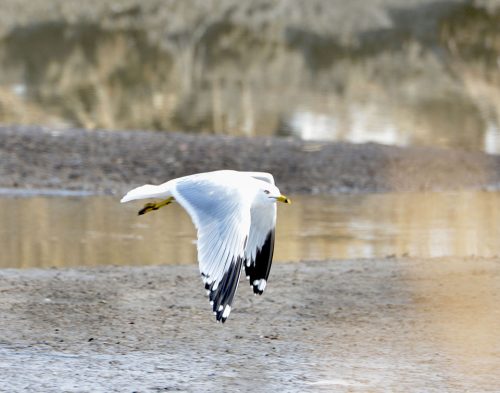
“All gulls, NOT seagulls.”
If you are new to birding or have been around birders, you may have had the same experience. Gulls are listed under “gulls” and, to be accurate, there are in fact no creatures called seagulls.
By the way, another great way to be schooled by a birder is to call a Canada goose a Canadian goose. When you get corrected you will know you are around a serious hobbyist who loves to nitpick, and no one likes to nitpick more than birders. (I’m probably going to pay for that one.)
Paradoxically these nitpickers are the same folks who will call nondescript tiny birds LBJs (little brown jobs), a woodcock a timberdoodle, a yellow-rumped warbler a butterbutt, a great blue heron a GBH, a pileated woodpecker logcocks, or a turkey vulture a TV… but don’t you dare call a gull a seagull.
The novel Jonathan Livingston Seagull was an allegorical fable. Maybe this was a clue that seagulls don’t exist?
One reason for not calling gulls “seagulls,” besides the fact that it’s really not their name, is that gulls don’t live exclusively near the ocean/sea.
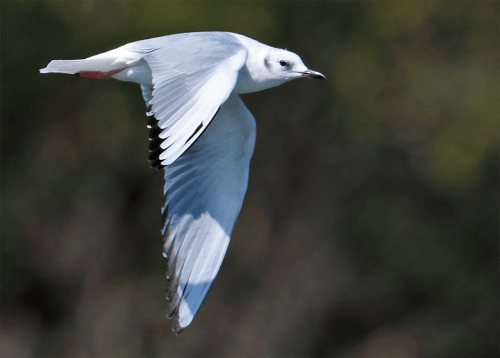
But probably the easiest way to avoid the error is to learn to identify the most common gulls in our area and just use their correct common names. Then when you visit the shore this summer you can show off some of your gull knowledge, so that while your tasty tidbit is taken on an aerial tour of the boardwalk before being scarfed down you can say, “That laughing gull (or herring gull, or whatever) just took my French fry!” Be sure to say this with indignation.
A research group in the United Kingdom did some studies of food-snatching herring gulls and found out that those who were watched or stared at were less likely to steal your meal. They contended that most gulls were actually not predisposed to snatching food. However, I think it is safe to say those birds hanging about near a boardwalk fry vendor know their quarry all too well, and it’s not their first rodeo. In the study some subjects’ snatching expertise was well-honed and they made their move within four seconds of sizing up their prize—gaze or no gaze.
Gulls are a competitive species and can be very crafty, so that they can be revered or despised. Most of their bad habits around humans are caused by our interactions. And their bad habits around nesting colonies are primarily survival of the fittest, for which they seem very fit.
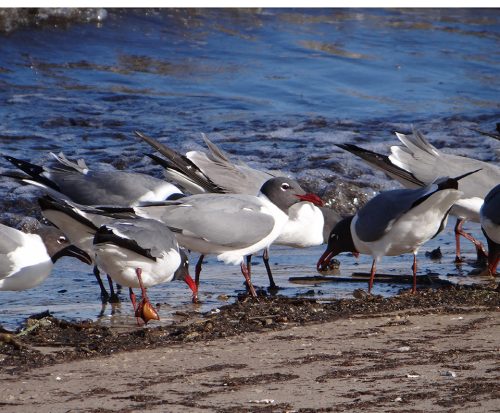
Let’s move on to some gull identification skills. They can be a bit challenging especially because they have breeding, nonbreeding, and immature plumages. We will stick to New Jersey’s most common gulls—great black-backed, herring, ring-billed, laughing, and Bonaparte’s. Terns can have a turn some other time.
- We’ll start with the king of the beasts, the great black-backed gull. This predatory gull is North America’s largest. With a length of 30 inches, a wingspan of 65 inches and weighing a hefty 3.6 pounds, it is often identified by its bulk. As its name indicates, its back and wings are black. The adult’s body is white with pale pink legs. The beak of the mature bird is yellow with a red spot on the bottom mandible, like a woman who has put lipstick on her lower lip only. When immature, during summers one and two, its plumage is coarsely checkered white and black. It is a coastal species and is rarely found inland.
- Herring gulls are also large: 25 inches long, a wingspan of 58 inches and a weight of about 2.5 pounds. Sibley offers that they can be confused with many other species because of their variability. The adult is easily distinguished from the black-backed gull because its wings are gray. The immature is checkered but not as heavily as the black-backed and it is tawnier in color. It too has pink legs. It is not until its third winter that it gets its adult plumage. Herring gulls venture inland to lakes and rivers, and are also found in harbors and garbage dumps.
- The ring-billed gull is 17 inches in length with a 48-inch wingspan, so it’s considerably smaller than the previous two. And it is just half the weight at 1 pound. The mature bird has a gray back and a yellow bill with a black ring near the tip. It has black tail feathers and greenish-yellow legs. The juvenile is more mottled than checkered, but by its second winter it looks nearly identical to the adult. They are commonly found inland.
- The laughing gull is 16 inches long with a wing span of 40 inches, and it weighs 11 ounces. In summer the adult is easily distinguished from the other species because it has a black head and a call that evokes laughter. In the non-breeding season it has a hood across the back of its head but not the full cap. With a white body and dark grey wing, its legs are dark red to black. Laughing gulls are more agile flyers than their aforementioned cousins and almost tern-like (stream-lined). Herring gulls prey upon their eggs and their numbers are decreasing. The laughing gull is seldom found far from salt water; it is a true coastal species with its largest known colonies in Stone Harbor, New Jersey.
- The Bonaparte’s gull is smaller yet, with a 13-inch body, a 33-inch wingspan, and a weight of only seven ounces. During breeding season it has a black cap. Nonbreeding its head is white with a dark ear spot behind its eye. In New Jersey we see it in nonbreeding plumage, with a black bill and pink legs. It has gray wings with flashy white wing tips. None of the other gulls discussed have the large white wing tips so this is diagnostic. The best time to see them in New Jersey is in the winter after they have left their northwestern Canada breeding grounds. They are unique among the other gulls in that they are tree nesters, while the others mentioned lay their eggs on the ground.
Other gulls that are seen in New Jersey but less likely to be spotted are the black-headed, glaucous, little, lesser black-backed, Iceland, and black-legged kittiwake.
While some advanced birders have a habit of hasty corrections, they are usually well-meaning and simply intent on sharing their enthusiasm and knowledge. Clay has fostered an interest in birding in thousands of people, offering his spontaneous enthusiasm and great expertise. Before he may suggest a correction he is likely to moderate it with praise such as, “Good spotting, it appears to be a laughing gull. There actually isn’t any species called a seagull.” I suppose we could all learn by his example!
Happy birdwatching! And this summer don’t forget to stare down the gull that is eyeing your meal. n
Sources:
- “Herring gulls respond to human gaze direction.” Goumas, M., Burns, I., Kelley, L.A., Boogert, N.J. 2019.
- The Sibley Guide to Birds, David A. Sibley. Consulted for size references.









